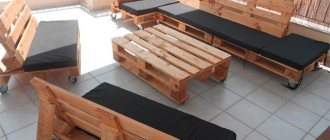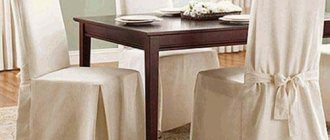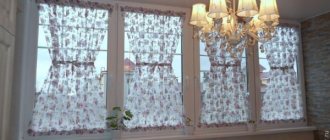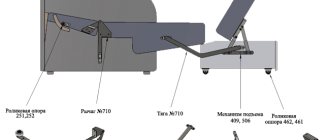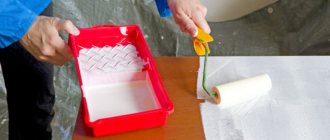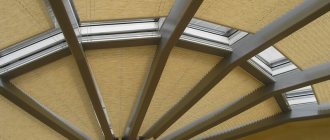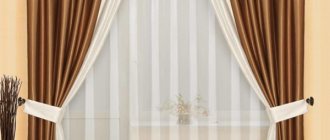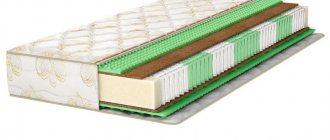The technical, or utilitarian-household role of upholstered furniture covers is obvious: to extend the service life of rather expensive and significant pieces of furniture in interior design. Sewing a chair cover with your own hands is not a difficult job. Removing it and washing it is easier and simpler than cleaning the original upholstery, and replacing it is much simpler and cheaper than reupholstering.
Special mention should be made of the aesthetic significance of the chair cover. Only the ever-memorable Dasha Bukina would think of placing a sofa in the middle of the room. A chair, by its very nature, is certainly a significant element in an interior. And in a cool loft, and in a mini pressed to the limit, and in an infinitely sophisticated shabby chic, you want to relax in a chair comfortably, otherwise what is it all for? A skillfully designed and executed cover allows you to fit any, without exaggeration, chair into the interior of any style. English “eared” in a loft, French Voltairean in a mini, futuristic office in an empire style? No problem, see photo:
Armchairs with covers in the interior
Sew or wear?
Before examining your favorite seat and thinking about how to cut it all out and sew it into one, it wouldn’t hurt to ask yourself: why do my chairs need covers? If only from dust and dirty alien trousers, then perhaps it would be better to just buy a universal chair cover made of stretch fabric with an elastic band - such covers simply stretch over it. Unfortunately, there are fewer stretch covers for an armchair on sale than for a sofa or chair: the enhanced individuality of the former affects it. Whether a potential buyer knows at least something about the principles and rules of creating an interior design or not, he definitely does not want to give his favorite or prestigious chair in the living room the appearance of “like everyone else.” Demand dictates not only supply, but also price: Jacquard NEW will cost about 8,000 rubles; Turkish Bulsan approx. 6000 rub. The design of both is quite monotonous - it is dictated by the properties of the fabric. The colors are modest. In addition, the Turk's elastic band soon stretches, but for a dust cover this is not very significant. If standard design solutions fit into your interior, then New Life covers made from thicker, more refined fabric and more varied colors may be suitable, see video
Video: example of purchased chair covers
Stretch covers for upholstered furniture have one common property: it is either completely impossible or very difficult to sew them with ordinary thread on a regular sewing machine, and the quality of the finished product will be noticeably worse than the factory one. This is especially true for functional chair covers - computer and office, see below. And, finally, if you need a decorative cover to give an individual look to a prestigious chair in the interior and/or fit it into the interior, then sewing it yourself is almost the only option. Let’s say the price of custom tailoring is from 10,000 to 60,000 rubles. and doesn't scare you anymore. But where is the guarantee that the master will understand your vision of the situation and your plan?
Types of removable chair covers
Today, several types of removable seat covers are common:
- with ties - textile products reminiscent of ordinary bedspreads. Thanks to the fastenings in the form of ties, such covers fit tightly to the furniture and protect it from various types of dirt. Often such products are decorated with bows, zippers, rivets, and so on;
- tension - can be made of ordinary material or of a special, well-stretchable elastic band (Euro covers). Such products fit as tightly as possible to the furniture and at first glance resemble furniture upholstery. They are made only from elastic types of fabric.
With ties, tension
Which one to sew?
First of all, let's decide what type of cutting the cover will be - the choice of fabric and the method of cutting the patterns for the pattern depend on this. This is directly related to the design of the case, because... Not all fabrics suitable for it are available in all colors and patterns.
Chair covers of different types of cutting
You can sew a cover for a chair at home. types of cutting (see also fig.):
- Fitted and flared – allows you to fit the chair into any interior. The fabric required is sufficiently elastic, the same as for a computer chair cover, see below. It is not suitable for a chair with a high turn-down back and/or a large camber of armrests - it will not be put on or taken off, but it is suitable for Voltaire chairs and others with a straight back and armrests. The only aesthetically suitable cover for a chair in the interior of minimalism and high-tech styles. Suitable fabrics for this type of cover are available in both modest and bright colors, but not very variegated colors. A significant part of ready-made covers are cut in a tight-fitting, flared fashion. Making patterns and creating a pattern with your own hands requires sufficient attention, accuracy and skills in cutting and sewing;
- Tight-fitting with a frill “skirt” - fits any chair into interiors usually called bourgeois - empire, art deco, shabby chic, haberdashery. If the fabric is soft and its colors are chosen tastefully, any chair will also fit well into the interiors of the Greco-Roman clone (French, English traditional), Baroque, Rococo and other classics. Any fabric is suitable, because... At the junction of the skirt with the top, an elastic band can be inserted without any problems, and skillfully straightened folds in the vertical corners and on the back of the back do not spoil the overall appearance. The most common and universal type of cover. Ready-made covers are most often cut to fit with a skirt. Creating a pattern, cutting and sewing with your own hands does not require high professionalism;
- Semi-loose cut - tightened to fit with ties. Again, any chair fits into interior styles according to the previous one. point, and also in country, colonial and oriental. If the ribbons for the bows are replaced with straps with fasteners or Velcro or cords tied to the strings, the chair will fit into the interior of a modern clone (except for mini and high-tech) and into the loft. Fabric – any. Minimal cutting and sewing skills are required, so semi-loose-cut covers are most often sewn by amateurs. In professional tailoring it is used less often, because requires 10-30% more fabric than tight-fitting ones, and does not provide obvious arguments to explain the difference in price;
- Loose fit - the whole thing is pulled to fit with cords or elastic bands. The fabric needs to be thin and non-caking. Suitable for country and colonial interiors. Sometimes shabby chic or loft. The complexity of cutting and sewing requires complete professionalism. Care is difficult. Short-lived. The chair does not protect well, because... collects dust.
Note: using the example of a tight-fitting cover without widening at the bottom, it is convenient to explain the rules and techniques for removing pattern pieces, see below. But it doesn’t look good on the chair, because... You definitely need a zipper, fasteners or ties in the backrest, which is always visible on the chair.
About capes
Simple protective capes without a pattern (item 1 in the figure) are rarely thrown over a chair and are most often removed later. The reason is that the traction area of the seat tires and the cover on the chair is several times smaller than on the sofa, and sitting in the chair is usually not so calm. As a result, the cape gets wrinkled every now and then.
Chair covers without a cover and with a cover
A simple cover is sometimes placed on a chair, firstly, to protect the most vulnerable parts of an expensive decorative cover. In this case, it is sewn either from the same fabric as the cover, pos. 2, either matching it or contrasting. Secondly, capes made of dense, perhaps not very beautiful, but durable and resistant fabric are used to cover chairs placed, for example, on a veranda, terrace, in a gazebo, under a canopy. In general, somewhere outside.
The basis of the cape for a decorative cover is a straight piece of material, on the left in the figure:
Covers for a chair in the room and on the veranda (in the gazebo, under a canopy)
Next, sew as a cover-cover without a pattern for the sofa (in the center): wings are attached to the front-seat-back-back section. It is better to make a protective cape for a chair that may be exposed to external influences from 3 separate parts: a common panel and armrests. Along the free edges, turn ups of 3-4 cm are given, which are stitched, and eyelets are placed, as in curtains, on the right in Fig. A cover of this design can be covered with cords so that the original upholstery of the chair will not be visible at all.
How to sew a chair cover with your own hands: instructions from craftsmen
Learn how to sew a chair cover and update your interior
No matter how well the upholstery of upholstered furniture is preserved, over the years the same pattern becomes boring. Reupholstery is expensive, and we are starting to think about how to sew a cover for the chair in order to somehow update the interior. In fact, a properly made cape from good fabric works wonders. The room becomes completely different, especially if the material contrasts with the previous upholstery in quality and texture.
Learning to sew a chair cover
General recommendations for sewing covers
- First, look around the room and think about what fabric to choose for the cape. Women know very well how a branded bag can change their wardrobe - they have to urgently select everything else to go with it. The same thing happens with the housing situation. Covers made of genuine leather will require expensive parquet and suspended ceilings, and colorful chintz in a classic interior will look like a poor relative.
- Choose a fabric that is durable and wrinkle-resistant, because the cape will be subject to considerable stress every day. In addition, it is easier to grind thick material; it does not wrinkle so much. It is better not to take fabric with large flowers, checks, or prints, especially for novice needlewomen. You may simply not be able to adjust the pattern, and the covers will look ridiculous.
- As for the cut. An inexperienced seamstress must first cut and sew a chair cover with her own hands from an old sheet. Don't waste your time on this. Firstly, you will gain experience and understanding of various difficult moments in work, and secondly, you will not have to sprinkle ashes on your head because of damaged expensive fabric.
Measuring the chair and calculating the required footage of fabric
The configuration of furniture today is very different, so capes are actually sewn on the chair itself. Let's take a model with frills. First, let's decide where the seams of our cover will go. The easiest way is to make them where the seams of the upholstery itself are laid, then the cape will repeat the silhouette of the chair with greater accuracy. If you are planning to sew covers of a radically new style, mark the seams directly on the upholstery (preferably with soap). We immediately take into account inserts for thickness, bends, and contour alignment.
We measure all the parts of the chair (back, seat, armrests, border, pillow, if there is one) and write down the resulting numbers. The length of the fabric for lush frills is calculated as follows: the perimeter of the chair must be multiplied by two. In order not to get confused in the names, we write the part number, its width, length, depth.
Measuring chair parts
When calculating the footage, it is necessary to take into account darts and tucks, without which there is no tight fit, as well as hems, folds, and frills.
For each pattern element, in addition to seam allowances, we add about 20 cm for overlaps and adjusting the cover. We measure parts of a non-standard shape by placing thin strong paper on them and crimping it on all sides. You can additionally outline the folds with a pencil.
We cut the resulting tracing paper along the lines and put it back in place. Do not achieve perfect alignment, we need an approximate pattern to make a general pattern for the part. We will customize it locally. After measurements, we draw patterns for all elements of the chair on graph paper and calculate the final fabric consumption.
Now we prepare everything you need to sew a chair cover with your own hands:
- A piece of inexpensive fabric for a rough cover (chintz, muslin or, as we already said, an unnecessary sheet).
- Thick, beautiful fabric for the cover.
- Lightning.
- Centimeter, ruler, scissors.
- Pencil, chalk or sharpened piece of soap for markings on the material.
- Pins with an eye for chopping fabric, needles, threads, cord for piping.
- Furniture clips for attaching the cover to the chair.
- Sewing machine.
Cutting fabric
We lay out the paper patterns on the fabric in the most optimal way so that there is as little material waste as possible. We chop off the paper with the material and trace the patterns with chalk. If the stock for allowances has not yet been added, add it now. Cut out the details. All cut out patterns are ironed from top to bottom along the longitudinal thread.
Cutting and joining parts of the backrest and armrests
- We fold the cut out part of the outer part of the back in half, marking the middle along the longitudinal thread. Unfold it, place the pattern on the back of the chair and pin it in place. When cutting out a chair cover with your own hands, be sure to mark the lines of future seams with a pencil. We repeat all the steps with the pattern for the inside of the back.
- We combine and cut both patterns along the top of the chair. We bend the extra fabric at the upper corners and on the inner pattern, forming neat darts. We pin them together, stretching the fabric moderately. Cut off the excess, leaving 5 cm on each side.
- We cut out the inner pattern where the backrest meets the armrests, leaving small allowances (2-3 cm). We tuck them into the gap between the back and armrests. Draw a seam line at the junction of the backrest and the seat.
Pattern for the back of the chair
- For each armrest we cut out two patterns - outer and inner. We pin the outer part of the armrest to the outside, after first folding the fabric in half and marking the central longitudinal thread with a pencil. The lower edges of the fabric should overlap the intended seam of the frill by 1.3 cm. We cut the outer back and armrest patterns with the edges outward. Draw seam lines.
- The inner part is connected to the outer part at the place of the outer seam laid with a pencil. The inner pattern should have a good margin on all sides (18-23 cm). One of its sides extends 18 cm onto the inside of the backrest, the other – onto the front of the armrest. Place the lower edge of the workpiece on the seat.
- We chop off the outer and inner parts of the armrest in front, laying folds diverging from one point. This is one of the ways to carefully make chair covers with your own hands; below we will look at the second.
- We put tucks on the outer part of the armrest, below, under the curve. All excess fabric will go there. We draw seams at the beginning and end of the pintuck line, mark them on the outside of the back and on the inside pattern of the armrest. On the inside of the chair we mark the joints with lines. We repeat all operations for the second armrest.
Pattern for the armrest (first option - with folds)
Option No. 2 – for wide armrests
The voluminous front part of the armrest does not always look good with the radiating folds mentioned earlier. Then we cut out a special insert for it. We pin the inner armrest pattern in place, mark the seam on the front part and cut the fabric along it, leaving a 2 cm allowance.
We cut out the insert and pin it around the perimeter of the front part. Draw a seam line. We chop off the insert, the inner and outer patterns of the armrests with the edges facing out.
Pattern for the armrest (the second option is for wide armrests)
Cutting out the seat parts
We place the seat pattern with a margin of 23 cm in place so that its bottom is on the line where the frill begins. We combine the parts of the back, armrests and seat. We mark the places of internal connections of the chair with bold dots or in another way that is understandable to you. We cut the excess fabric, fold the darts at the front corners of the seat and pin them. DIY chair covers are already taking on a certain look.
We chop off the seat piece with the outer armrest pattern and mark the seam line that will connect them. We tuck 1.3 cm of fabric into the gaps between the back and the armrest. We draw seam lines along these places.
Seat pattern
What to sew from
First of all, what you shouldn’t use to sew a cover for upholstered furniture:
- Any cotton fabric is cheap, but fragile and short-lived. A cover made of cotton, even industrially decatified, for example. jeans, doesn’t hold its shape, easily creeps and wrinkles. And most importantly, cotton fabrics freely allow moisture to pass through, and dirt, grease and grease are transferred to the original upholstery, as they were specially invented for this purpose. This is not bad in clothes, but it brings dirt and skin secretions outside, but not into the chair.
- Wool fabrics are allergenic. Their close contact with the body is unacceptable; At present, woolen underwear is not produced. Wool readily absorbs moisture and grease, which is why it seems difficult to get dirty. But, as you know, wet or simply worn woolen clothes need to be dried. Dry particles of dirt are pushed out of the wool - it has the property of self-cleaning. However, if a woolen cover covers the chair, then at least half of the accumulated dirt will be given to it.
- Velvet and velor accumulate dust, dirt, and grease and transfer it to the chair. Poorly cleaned and washed. They wear out quickly from regular cleaning and washing.
- Silk, satin, scallop are slippery, the cover tends to slide off. Squeezed folds quickly cake and are difficult to straighten. They get wet and leave grease on the chair, which is only slightly worse than cotton. They accumulate static.
The chair cover needs to be sewn from:
- Protective technical – the best material is linen canvas. Even better is a painted canvas. If it is impregnated with a water-polymer emulsion, the cover will become waterproof. In second place are synthetic dress fabrics for outerwear. The advantage is the variety of colors, but they adhere less well to the original upholstery. On the third, for the chairs outside, there is hemp (made from hemp fibers) or propylene matting. On the last one there is a homespun (hemp cloth).
- Bright colorful decorative - from any furniture upholstery fabric.
- Decorative prestigious - jacquard, chinille and other traditional dense upholstery fabrics. But the best option is modern semi-synthetic upholstery, like for a computer or office chair, see below.
DIY computer chair cover
To sew a cover for a computer chair, you need to follow this plan:
- Fabric is selected. For such a product, less than 1.5 meters of fabric will be enough.
- The width and length of the chair are measured. The length of the furniture, in this case, is the distance from the floor to the seat. The seat will also need to be measured, this is the width of the furniture.
- A pattern is made. You can attach paper, newspaper or unnecessary fabric to the chair. The main thing is to build a pattern according to the measurements taken!
- The arms of the computer chair will not be covered by the case. In addition, many of these chairs do not have handles at all.
- Using a sewing machine, a cover is made according to the pattern. The line should be even.
- At the last stage, it is applied to the product to verify correct operation.
If something is done incorrectly, it is recommended to cut the case and sew it again.
Constructing a pattern
A cover for a chair is cut and sewn in generally the same way as for a sofa. But the different geometric proportions of the chair and the procedure for using it place increased demands on the accuracy of taking patterns from life and cutting fabric. If, for example, you take a pattern for a sofa cover from the same set, throw out the middle of it and sew a chair cover from the rest, then it will almost certainly wrinkle in plain sight, see fig. on right.
Wrinkles on seat covers due to improper cutting
What parts does the pattern of a tight-fitting chair cover consist of, is shown in the figure:
Scheme for constructing a pattern for a chair cover
By widening the back, armrests and front from below, we get a pattern for a cover with flares or a skirt. If you need a semi-loose cut cover, the overhangs of the armrest parts are made straight. For an example, see a selection of videos on how to cut and sew a cover with frills for an armchair:
An example is a good thing, but if you need your own original cover for your own chair, not the same as in the example, and you like a different fabric, then you need to keep something else in mind. In Fig. Above, you can already see the differences between the pattern of a cover for a chair and that for a sofa: the cuts for the front, seat, back and back of the back are elongated in length/height, while for the sofa, on the contrary, in width. The cut for the back of the sofa is also elongated in width, but here it needs to be almost square. If the fabric stretched exactly the same in all directions, it would mean nothing. But it stretches differently along and across. And in a chair cover, the armrests pull the seat more strongly, and its area of contact with the base is smaller.
How to thread a piece of thread and take measurements to create patterns for a chair cover
The first thing that follows from this is that the threads of the cover fabric must be threaded as shown on the left in the figure:
- Facade, seat, back - along the top, deep, up, down.
- Armrests - up and down across.
- Front inserts of straight armrests are vertical.
- Inserts for armrests with camber – give the lobar ones a camber of approx. 1/3 along the top from the greatest extension of the armrest.
That is, cutting the fabric for a chair cover at random, just to save money, will not work - there will be irremovable wrinkles on the finished cover. It is necessary to remove the patterns from the chair, mark the orientation of the lobes on each one, lay them out on the floor in a strip equal to the width of the cut of the chosen fabric and minimize waste, observing the necessary orientation of the lobes. Then the required cut length is measured locally and purchased.
How to remove patterns
For patterns you need to prepare or purchase suitable material, see below. Then the chair is measured, as shown in the center in the figure, and according to the measurements, blank pieces of approximately the same shape are cut out from the pattern material with an allowance of 10-15 cm. The blanks are placed in place, pulled up, crimped at the joints and the contours are drawn with a marker; the orientation of the lobar is immediately noted. After this, the blanks are cut along the contour with an indentation of 7-10 cm and laid out to determine the length of the cut, see above.
Insertion is a delicate matter
If the chair has a large camber of armrests, and the fabric of the cover is chosen to be dense and not very stretchy (jacquard or flock, for example), then the patterns for the inserts in the armrests should not be removed by drawing them in place, but built according to size. Building on a regular grid is tedious and inaccurate - you will almost certainly get lost. Building on an arbitrary grid of basic verticals and horizontals will also take time, but the probability of error is much less and the accuracy is higher. You just need to make a device in addition to the tailor's meter - a simple caliper from a pair of wooden rulers with holes; the length of the rulers is from 30 cm. The ends of the rulers opposite to the holes are cut at an angle of 30-45 degrees towards each other, i.e. mirrored, and the rulers are fastened through the hole with a bolt and nut. The measurement procedure is as follows (see also on the right in the figure):
- Prepare a simple plumb line from some kind of weight and thread or fishing line;
- In nature, along a plumb line, using chalk or soap, mark the base vertical A from the middle of the base of the insert;
- In the same way, mark the base vertical B from the pole of the armrest P - its highest point;
- The main horizontal line is drawn on the template sheet;
- Measure hA - height A from the line of the curb of the chair;
- Construct a basic vertical A on the workpiece;
- On location, measure the distance between the basic verticals C;
- On location, measure the full height of the base vertical B from P to the curb line, and the height of the dip B - hB;
- Based on the data obtained, a basic vertical B is built on the workpiece;
- On location, the arms of the horizontal lines A0 – a(n) are removed using calipers and transferred to the workpiece. The horizontals are placed more often, the steeper the bend of the sides of the insert contour in a given section and the closer they (horizontals) are to the pole. The heights of the horizontal lines are measured with a meter;
- Similarly, the arms of the horizontal lines B0 – b(n) are removed and transferred to the workpiece, but the measurements are taken downwards from the pole;
- Using a regular drawing pattern or by hand, draw the outline of the insert on the workpiece.
The highlight of this method is that in the most critical places, where wrinkles can appear on the product, the shoulders a(n) and b(n) duplicate each other to some extent. Suddenly, when drawing, it turns out that their end marks have diverged greatly; measurements at this level can be repeated, because an error in beating any pair of horizontal arms is not transmitted to the others.
What to make patterns from
The material for the patterns for the chair cover should stretch approx. just like upholstery fabric, and apply it in place, wrinkled in the same way. Then you will immediately see where the cuts for darts are needed or, if there are more than 2-3 of them, where this part needs to be divided into two.
In professional tailoring, pattern pieces are cut out of percale - fabric that has been decatified 3-4 times and impregnated with a special composition. Decorate the canvas by soaking it overnight in initially hot water, drying it and ironing it until dry while still wet. Percale is sold in specialized sewing stores, but in small towns this is most likely not available. You can, of course, order it on the Internet, but if you only need a cover for one chair, you can also wash and starch an old, washed sheet - it has already been dried naturally. However, such a pattern will be disposable: the starch will soon be knocked out, and there is no point in starching again - the dimensions will float away. In most cases, if the chair is not particularly pretentious in shape, percale can be replaced with building insulating material - glassine. You can find it in any hardware store, or they can bring you a custom-made cut from the warehouse. Using glassine patterns, you can cut out covers for 5-6 chairs, which is more than enough for yourself.
Basting a blank pattern for a chair cover made of sheet insulating material
If the cover is insulated, then instead of a pattern you can use the insulation itself - thick sheet polyester, artificial felt, etc. Insulation blanks are applied in place. Working seams are basted with a thick thread, and basting seams for cuts are sewn with a thinner thread of a contrasting color, see fig. on right; The stitching and cutting lines are marked with a marker. In this case, when cutting, you need to add the thickness of the insulation to the sewing allowance.
We sew chair covers.
1) So let's begin. Measure the chair using a tailor's tape measure . Draw an approximate pattern of the cover and mark all the dimensions on it (length and width of the seat, back and armrest). Draw patterns on graph paper or plain newspaper, adding 10-20 cm on each side - these allowances are needed so that you have enough margin for adjustment during the sewing process. Of course, an experienced seamstress may not need patterns - she will be able to immediately mark them on the fabric. But a novice seamstress will feel more confident if she sews a test cover from inexpensive fabric (an old sheet will do just fine for this purpose).
2) Lay out the patterns on the fabric and trace them with tailor's chalk or a thin dry piece of soap. In order not to complicate your work, make the main part of the cover one piece (the one that will cover the back and seat). Armrests can usually also be cut from a single piece of fabric: to do this, fold the fabric in half and cut out the parts according to the pattern. If your chair has wide, voluminous armrests , calculate and cut the inserts in the center (usually they are made when the armrest thickness is over 8 cm). Sweep away the cut parts. Place the resulting “draft” of the cover on the chair and carefully smooth it with your hands along all the seams, depressions and bends. The allowances left during cutting will allow you to adjust the cover so that it fits tightly to the chair; If necessary, mark and pin darts or tucks.
3) Try on the resulting blank on the second chair and try to find the “golden mean”, remembering that you need to sew two covers that will fit equally well on both chairs. As a rule, the sizes are the same and there is no need to specially adjust the cover for the second chair.
4) Proceed directly to sewing. First, sew and iron stitches or tucks on all parts. Then sew the parts of the armrests of the chair. Before turning them right side out, make a cut in the corners, not reaching 0.5 cm from the seam - this will make them look neater. Fold the main part of the cover with the parts of the armrests with the right sides facing inward, carefully baste them and stitch them together. Zigzag all seams. Now turn up the bottom edge of the cover by 4 cm, iron and hem. Sew the second chair cover in the same way. Turn both covers right side out and place them on the chairs. Ready! Using our useful tips, all you have to do is admire the results of your work. The chair is now like new!
Sewing
Sewing a cover for a chair has no significant features. It’s even simpler than many other cases - you don’t have to leave the armhole under the turnout and then sew it up. You need to sew with a thread that matches the density of the fabric: thick approx. No. 20; thin No. 30-No. 40. All seams along the contour of the seat are reinforced, see figure:
Reinforced seam for sewing chair covers
If the cover has edgings, they are sewn into the parts before sewing them into the product; the exception is the edging on the curb line. The allowance for parts with edgings is increased by 3.5 times the thickness of the insert cord. The edging on the front parts of the armrests is made on their inserts; the piping on the back is on its details, not on the back! Then the edging will straighten the part it frames evenly, and possible folds will disappear into parts that are less visible and visually significant.
Options for making seat covers
In this paragraph, we will consider two points: how to sew a cover for a chair of a standard structure (computer, hair salon, manicure, rocking chair), and also find out what algorithm is used to make a cover for a beanbag chair (it is also called a pear). Let's go in order.
Covers for standard seats
In the case of such interior elements, first of all, you need to figure out how to change the old upholstery that has lost its presentable appearance. So, when working with computer chairs, all actions are carried out according to the following algorithm:
- First, remove the backrest, which is held in place with one screw;
- then remove the protective cover of the backrest - pull the corners one by one, opening 4 latches;
- turn the chair upside down and remove the seat;
- remove the old upholstery from the disconnected components;
- we apply a new piece of fabric to them - it should be stretched well and the size estimated by eye (you can do without a pattern);
- we attach the fabric with staples from the wrong side (the vertical sides are attached first, then the horizontal);
- We fasten the corners diagonally in a similar way;
- After fastening, we cut off the excess fabric and put the chair back together.
Similar actions to replace the upholstery are taken in the case of hairdressing, manicure and office chairs. When working with expensive home chairs, a little more steps are required, because... there are also armrests involved.
After replacing the upholstery, you can safely begin making a protective cover. To complete this task you will need to do the following:
- attach transparent tracing paper to all furniture components;
- outline the borders of all elements with a pencil;
- cut out the necessary elements using tracing paper from the prepared fabric (be sure to take into account seam allowances; 5 cm is considered ideal);
- Sew all the components of the future cover.
The stitching process itself can be carried out in two ways:
- the cape is sewn on three sides (in addition to the bottom) on the wrong side; after stitching, the cape is turned right side out and put on the chair; This is the so-called double universal chair cover;
- the components are also sewn on three sides, but a 5-centimeter allowance is made; thanks to such a large allowance, the edges of the cover are folded and a kind of tunnel is formed; an elastic band can be inserted into this tunnel to secure the cape; in this case we are talking about a single cover with an elastic band.
In both the first and second cases, we make a cover for the tension chair. The only difference is that a cape with an elastic band will stick better to the furniture. The complexity of manufacturing and the amount of material used are almost identical.
Covers for bean bags
How to sew capes for such interior elements is a fairly popular question among many people. This is not surprising, because such products are in great demand today, but despite their high quality, they are still subject to wear and tear and require replacement of the coating. The increased interest in the issue under consideration is also due to the fact that pears (that’s what they are also called) are essentially dimensionless chairs (they do not have clearly defined geometric shapes, which makes it difficult to measure the required piece of fabric). However, the process of making a cover for such products is not very complicated. The main thing is to know the correct algorithm for the actions to be performed.
So, the basis of the “bags” are 6 separate pieces (they are also called wedges). To ensure that the wedges come out identical, you need to draw them on graph paper.
On a note! The optimal sizes of the pieces are equal to the following indicators: 120 cm in height and 45 cm in width.
The bottom is also drawn on graph paper. It should consist of two pieces of 60 and 70 cm, respectively. It is necessary to take into account that the wedges should narrow towards the top, so it is necessary to bend a sheet of graph paper in half, mark half of the design on one side, cut out the pattern without unfolding the sheet. You should end up with a hexagon. The top of the wedges and their base are cut out.
Then the cutting of the fabric begins. Prepared pieces of graph paper are applied to the fabric and cut out along the contour. After the preparation of all the pieces of fabric for the future cover is completed, you can begin the most difficult part of the process.
- Sew the pieces of the inner cover for the bag from the wrong side. Measure all pieces accurately after joining; they must be symmetrical.
- Connect the wedges with the right sides facing in. Sew the side seams, leaving a centimeter allowance. Iron any seams that appear. Turn the future cover right side out and stitch all the elements again (here you will need to take allowances). Fold the outer parts of the cover and stitch them at the bottom and top (40 cm each). Use the remaining 40 cm to sew in a zipper.
- Turn the product inside out. Take the cut hexagon and sew it to the top of the cover.
- Then start working on the bottom part of the product. Sew the bottom of the future cover to it.
- Sew the outer cover in the same sequence.
- Insert the inner cover into the outer one and fill it with granulated polystyrene.
Covers for special chairs
Special means computer, office and home work chairs for schoolchildren and adults. One cannot sit relaxed in such chairs. Riders constantly move in them. We are not talking about gamers, nervous regulars of social networks and hyperactive choleric managers. An ordinary calm and balanced person, engaged in systematic productive work, while sitting in a chair, without noticing it, fidgets all the time. A work chair should reduce fatigue, but if the cover on it keeps getting knocked down and slips, then, on the contrary, it will increase it. Everyone places certain specific requirements on the work chair cover.
Textile
Limitations begin with the choice of fabric. Thin upholstery usually doesn’t hold up on a work chair, but on thick traditional upholstery, sorry, it doesn’t take long to rub the buttocks. In any case, there is nothing to say about reducing fatigue.
Types of fabrics for covers of computer, office and work chairs
The best fabric for a work chair cover is the relax type, on the left in Fig. Relax fabrics are usually used to make car seat covers (we’ll talk about them later). The relaxation cover fits in place like a glove, does not accumulate static, does not rub anything even on a bare body, is easy to clean dry and can withstand repeated washing without losing its appearance. Relax fabrics are quite expensive, but at home, an almost complete replacement for them is woven nubuck, in the center. The flock upholstery on the right is somewhat worse - it gets dirty faster and you have to wash the cover made from it more often.
Note: microfiber can be considered a conditionally suitable fabric for upholstered furniture covers. The case made from it fits well and fits well into place. Microfiber collects and retains dirt and does not allow moisture into the chair. But it cannot be washed or wet cleaned, because... from them it immediately loses its properties. Regular dry cleaning will greatly shorten the lifespan of microfiber.
Which one to sew for work?
The work chair has a significant difference from the living room: its backrest is adjustable in height and its back is quite strongly convex - a rod, a slider and a regulator stopper are placed there. Therefore, it will not be possible to sew a work chair cover using a regular pattern: not only will it not look good, but it will also quickly fray on the fold.
Types of covers for work chairs
Ready-made covers for office chairs and computer chairs with increased ergonomics are produced in the form of cover-linings on ribbons with ties, fasteners or Velcro, pos. 1 and 2 in Fig. They cannot be called ideal: the ribbons are visible, weaken, come undone, the cover slips, and dust and dirt collect in its folds. For ordinary computer and work chairs, the so-called. bunny cover made of 2 separate parts, named after the very popular model with the image of a malevolent hare on the back, pos. 3a and 3b. The bunny cover is quite accessible to repeat with your own hands; how to sew a bunny cover for a computer chair, see video:
Video: original bunny cover for an office chair
The bunny cover, however, is also not ideal - it still creeps little by little and has to be adjusted from time to time. But a cover for a work chair of the type used for a living room (item 4) is not suitable at all: in addition to the dust collector fold, the fabric of the cover that crawls along the smooth armrests noticeably increases fatigue, and the cover itself keeps getting knocked down. In this case, a knitted cover is optimal, pos. 1 and 2 in Fig.:
Knitted covers for computer and office chairs
In the fold it hardly collects dust and does not get lost under a not overly active rider. It is securely fixed on the back with a knitted lapel, pos. 3. However, to knit a chair cover, you need to know how to knit, see video tutorial:
Video: knitted cover for a computer chair
Let's try to sew a universal one
Meanwhile, there are chairs in everyday use whose ergonomics are subject to much more stringent requirements. In cars. The driver, manipulating the controls, willy-nilly has to move a lot, and his mistake from fatigue is not seven troubles for you - one problem. And no mirrors, raid arrays or just backups for you. And covers for car seats have been developed for a long time. And any of them can be adapted for a computer and an office chair, because... Structurally the basics are similar.
So, take a pattern for a car seat cover (see figure) and start playing tricks with it. First, the lower part (seat) and upper part (back) do not have to be made of 5 parts, because The sides of both work chairs are low. Therefore, you can discard the parts highlighted in brown, and cut out the bases (grayish-green) as for a bunny cover. But you need to sew overlays (gray-dark purple) on them; their role is not only decorative.
How to remake a car seat cover pattern for a computer or office seat
Second, we sew the backdrop (bottom right in the figure) in one piece, but in 2 layers. The lining is made of durable technical fabric, and the decorative top is made of upholstery. We remove the ties E and F, and instead of them we sew a tight elastic band with hooks L to the back lining; on the wrong side of the back, the corresponding loops K are sewn. We cut the backdrop to be wider at the bottom, for which we remove the dimensions H1 and H2 from the base chair (top left in the figure). The height of the durable back lining is H1, counting from the top (the elastic is sewn to its bottom edge), and the height of the decorative overlay is H2. It is better to take elastic bands tighter, for example. from a car or motorcycle trunk.
When everything is sewn, we put on the seat and secure it with elastic bands - they are not visible. We put on the back cover, hook the hooks of its elastic bands to the loops. The durable lining stretches and securely fixes the backrest, and the decorative trim covers its locking screw, but does not interfere with its use. So we have a universal cover for a computer, office or work chair based on a car one.
Note: in order for such a cover to last longer and fit better in place, it is advisable to sew the front part of the back and seat in 2 layers with a lining made of durable technical fabric. In this case, elastic bands with hooks are sewn to the lining.
Style selection
The cover for a chair with a back makes a mark. Features:
- Saving - protects from damage, hides flaws. Pos. 1 and 2 in Fig;
- Accentuating - fits furniture into the interior, at the same time complementing and/or completing the concept of its design, poses 3-6;
- Props, pos. 7 and 8 - takes on a leading role in the appearance of the interior, most often together with the tablecloth. This allows you to hide design flaws or obscure decisions that are inappropriate in the circumstances;
- Decorative, pos. 9-11 - mainly at celebrations. In this case, universal covers (see below) make it possible to organize an extensive feast with “different-sized” chairs.
Types of chair covers
It is quite possible to sew chair covers that combine several of these functions, but then you should also be guided by the functional purpose of the cover:
- Everyday and accent - made from durable, hygienic, easy to wash, clean and iron fabrics, see below.
- Prop - since they are not used every day, the requirements for durability and washability of the fabric are reduced, but in return, pomp and luxury are required, otherwise it is impossible to visually draw the main accent of the interior onto the table with chairs.
- Decorative - the main thing here is the possibility of catchy decoration at low cost, the cheapness of the fabric, its minimum capacity for fat and liquids and maximum washability if the covers are reusable, for example. rental It’s clear what the covers and the furniture under them can turn into after a wedding or anniversary if they get wet well.
About capes
Covers for kitchen chairs
Covers for kitchen chairs are often made in the form of simple protective covers, see fig. on right. Make them conceptually accentuated with bows, decorative buttons (see at the end), floor-sweeping skirt, etc. accessories in this case are irrational. However, the kitchen also needs style with accents; especially if they are hosting guests. In this case, knitting will help out: knitted furniture covers are an absolute sign of good taste, skill and wealth of the owners. Meanwhile, chair covers can be crocheted very simply from fragments without a pattern or the ability to knit at all, see next. video:
Video: DIY knitted chair covers
Taking measurements and sewing
The cover is sewn together from four parts: a seat, a back, armrests and a skirt (it goes down from the seat to the floor). In order to make a pattern, you will have to measure the chair (length, width, height), create patterns, and then cut out the finished elements from the fabric. At the same time, leave 2-5 cm for seam allowances and 15-20 cm on each side of the part for “adjustment”.
Sew the parts together using a machine or by hand (back-needle stitch). If desired (or if appropriate), decorative elements are added: bows, cords, folds. The finished product is placed on a chair, which is previously cleaned of dust and dirt.
It is not difficult to sew a cover for frameless furniture, for example, a bean bag chair. The shape and number of parts largely depend on the shape of this piece of furniture (bucket, drop, large soccer ball). The fabric chosen is dense (leather, suede, curtain fabric), especially for the inner bag.
Difficulties may arise if you need to put a new or washed cover on a bean bag chair. In this case, it is necessary to ensure that the seam of the inner bag matches the zipper of the outer one. This will allow the material not to curl, and the filler to easily get into the upper part of the chair, imitating its “back”.
If you choose, sew and put on the cover correctly, it will help not only extend the “life” of the chair, but also decorate the interior.
Even with the most careful care, things will wear out over time. A computer chair is no exception. Armrests and seats are especially affected. The upholstery becomes dirty and torn, and now a thing that is still good in functionality becomes unpresentable. However, you shouldn’t immediately run to the store for a new one, because you can hide external imperfections with a cover for a computer chair. Even a novice craftswoman can sew such a cape with her own hands if she uses the step-by-step guide presented below.
